SARS-CoV-2
Search by Product Name or Number
Clear
 3CLpro Biosensors (3CLglow), SARS-CoV-2
3CLpro Biosensors (3CLglow), SARS-CoV-23CLglow Assay (C1160G)
$695.00–$3,895.00Price range: $695.00 through $3,895.00Select options This product has multiple variants. The options may be chosen on the product page
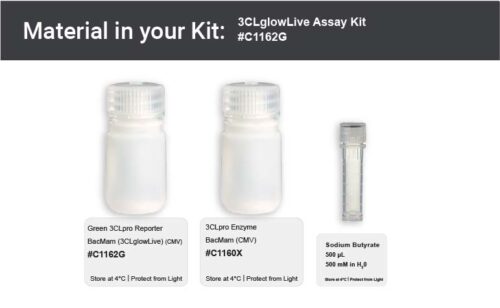 3CLpro Biosensors (3CLglow), SARS-CoV-2
3CLpro Biosensors (3CLglow), SARS-CoV-23CLglowLive Assay (C1162G)
$695.00–$3,895.00Price range: $695.00 through $3,895.00Select options This product has multiple variants. The options may be chosen on the product page
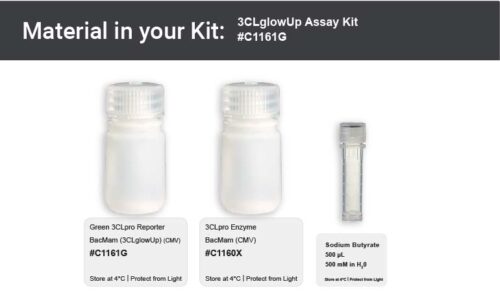 3CLpro Biosensors (3CLglow), SARS-CoV-2
3CLpro Biosensors (3CLglow), SARS-CoV-23CLglowUp Assay (C1161G)
$695.00–$3,895.00Price range: $695.00 through $3,895.00Select options This product has multiple variants. The options may be chosen on the product page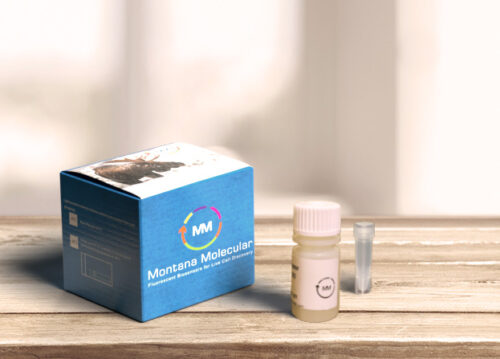
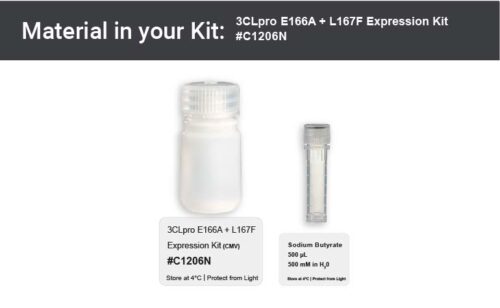 3CL protease and mutants, SARS-CoV-2
3CL protease and mutants, SARS-CoV-23CLPro Mutant BacMam – E166A & L167F (C1206N)
$595.00Select options This product has multiple variants. The options may be chosen on the product page
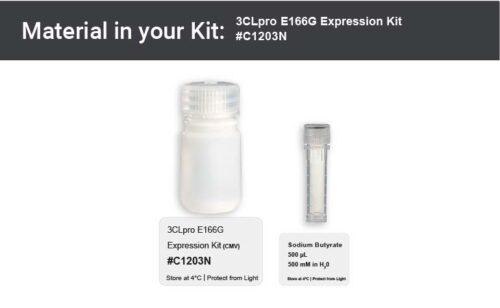 3CL protease and mutants, SARS-CoV-2
3CL protease and mutants, SARS-CoV-23CLPro Mutant BacMam – E166G (C1203N)
$595.00Select options This product has multiple variants. The options may be chosen on the product page
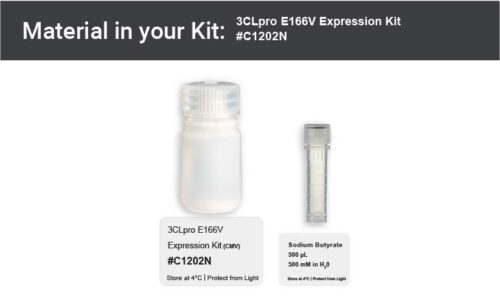 3CL protease and mutants, SARS-CoV-2
3CL protease and mutants, SARS-CoV-23CLPro Mutant BacMam – E166V (C1202N)
$595.00Select options This product has multiple variants. The options may be chosen on the product page
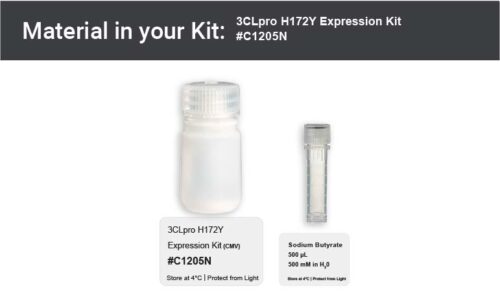 3CL protease and mutants, SARS-CoV-2
3CL protease and mutants, SARS-CoV-23CLPro Mutant BacMam – H172Y (C1205N)
$595.00Select options This product has multiple variants. The options may be chosen on the product page
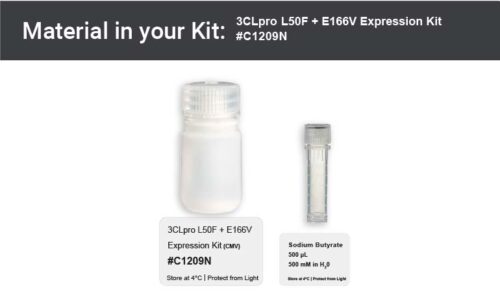 3CL protease and mutants, SARS-CoV-2
3CL protease and mutants, SARS-CoV-23CLPro Mutant BacMam – L50F & E166V (C1209N)
$595.00Select options This product has multiple variants. The options may be chosen on the product page
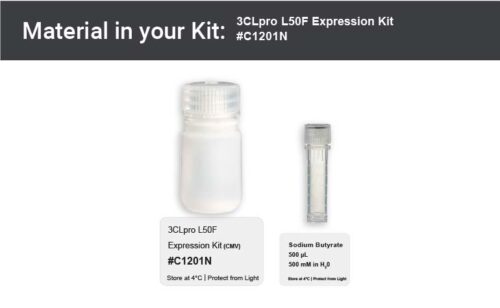 3CL protease and mutants, SARS-CoV-2
3CL protease and mutants, SARS-CoV-23CLPro Mutant BacMam – L50F (C1201N)
$595.00Select options This product has multiple variants. The options may be chosen on the product page
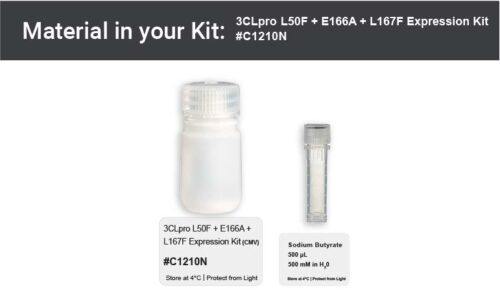 3CL protease and mutants, SARS-CoV-2
3CL protease and mutants, SARS-CoV-23CLPro Mutant BacMam – L50F, E166A & L167F (C1210N)
$595.00Select options This product has multiple variants. The options may be chosen on the product page
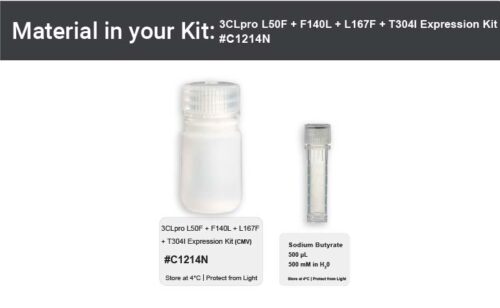 3CL protease and mutants, SARS-CoV-2
3CL protease and mutants, SARS-CoV-23CLPro Mutant BacMam – L50F, F140L, L167F & T304I (C1214N)
$595.00Select options This product has multiple variants. The options may be chosen on the product page
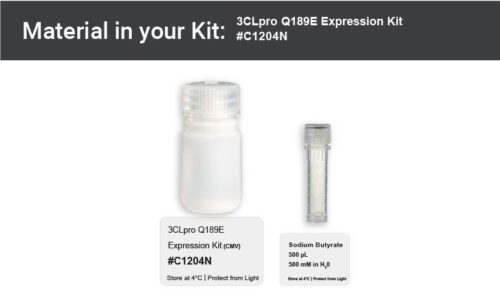 3CL protease and mutants, SARS-CoV-2
3CL protease and mutants, SARS-CoV-23CLPro Mutant BacMam – Q189E (C1204N)
$595.00Select options This product has multiple variants. The options may be chosen on the product page
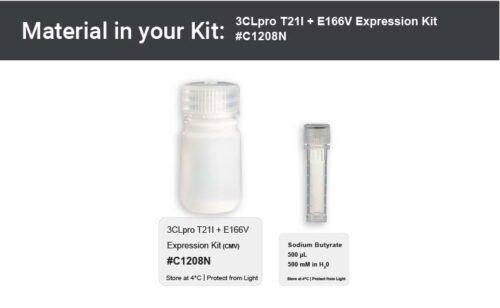 3CL protease and mutants, SARS-CoV-2
3CL protease and mutants, SARS-CoV-23CLPro Mutant BacMam – T21I & E166V (C1208N)
$595.00Select options This product has multiple variants. The options may be chosen on the product page
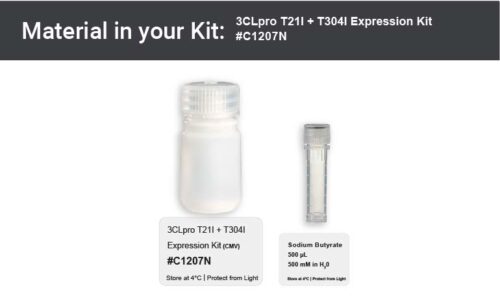 3CL protease and mutants, SARS-CoV-2
3CL protease and mutants, SARS-CoV-23CLPro Mutant BacMam – T21I & T304I (C1207N)
$595.00Select options This product has multiple variants. The options may be chosen on the product page
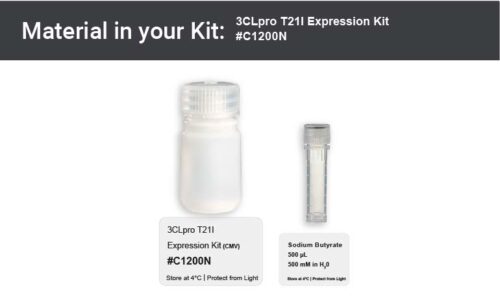 3CL protease and mutants, SARS-CoV-2
3CL protease and mutants, SARS-CoV-23CLPro Mutant BacMam – T21I (C1200N)
$595.00Select options This product has multiple variants. The options may be chosen on the product page
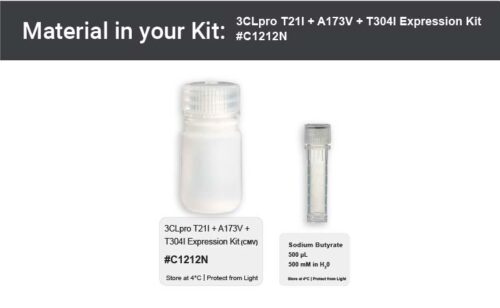 3CL protease and mutants, SARS-CoV-2
3CL protease and mutants, SARS-CoV-23CLPro Mutant BacMam – T21I, A173V & T304I (C1212N)
$595.00Select options This product has multiple variants. The options may be chosen on the product page
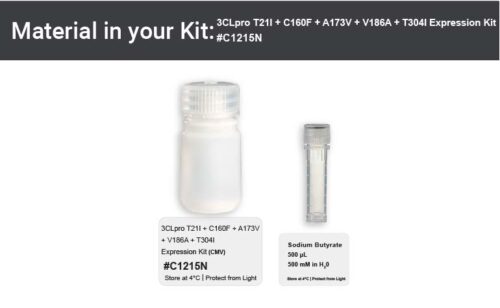 3CL protease and mutants, SARS-CoV-2
3CL protease and mutants, SARS-CoV-23CLPro Mutant BacMam – T21I, C160F, A173V, V186A & T304I BacMam (C1215N)
$595.00Select options This product has multiple variants. The options may be chosen on the product page
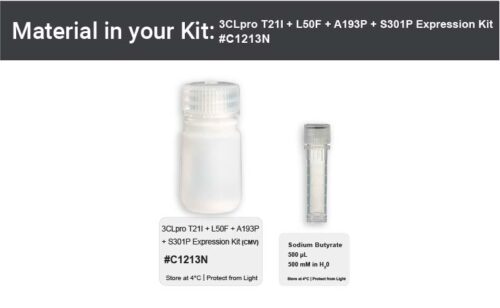 3CL protease and mutants, SARS-CoV-2
3CL protease and mutants, SARS-CoV-23CLPro Mutant BacMam – T21I, L50F, A193P & S301P (C1213N)
$595.00Select options This product has multiple variants. The options may be chosen on the product page
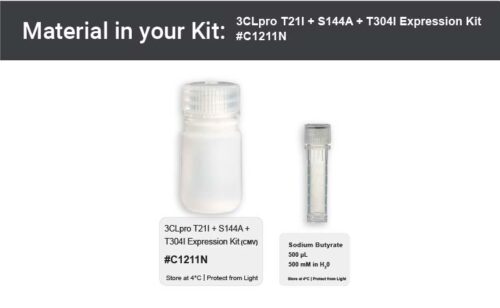 3CL protease and mutants, SARS-CoV-2
3CL protease and mutants, SARS-CoV-23CLPro Mutant BacMam – T21I, S144A & T304I (C1211N)
$595.00Select options This product has multiple variants. The options may be chosen on the product page
 SARS-CoV-2, SARS-CoV-2 Host Proteins
SARS-CoV-2, SARS-CoV-2 Host ProteinsACE2 BacMam – Green Fluorescent (C1100G)
$595.00Select options This product has multiple variants. The options may be chosen on the product page
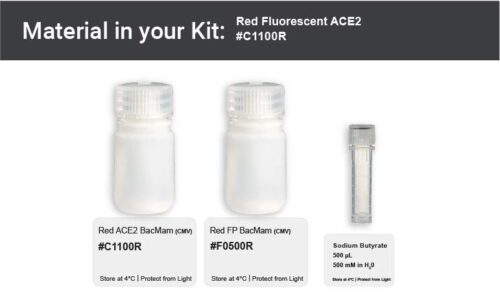 SARS-CoV-2, SARS-CoV-2 Host Proteins
SARS-CoV-2, SARS-CoV-2 Host ProteinsACE2 BacMam – Red Fluorescent (C1100R)
$595.00Select options This product has multiple variants. The options may be chosen on the product page
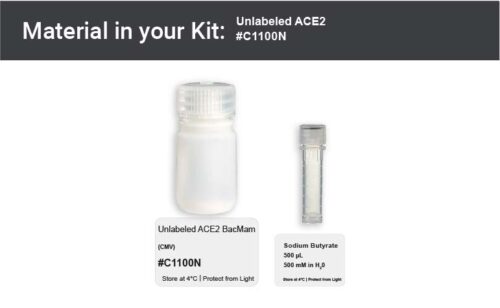 SARS-CoV-2, SARS-CoV-2 Host Proteins
SARS-CoV-2, SARS-CoV-2 Host ProteinsACE2 BacMam – Unlabeled (C1100N)
$595.00Select options This product has multiple variants. The options may be chosen on the product page
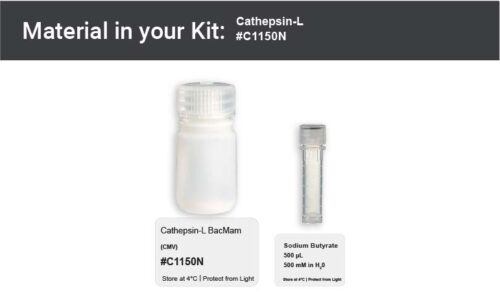 SARS-CoV-2, SARS-CoV-2 Host Proteins
SARS-CoV-2, SARS-CoV-2 Host ProteinsCathepsin L BacMam (C1150N)
$595.00Select options This product has multiple variants. The options may be chosen on the product page
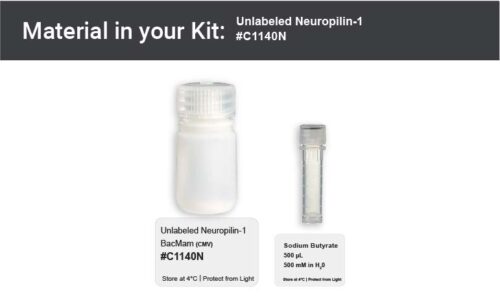 SARS-CoV-2, SARS-CoV-2 Host Proteins
SARS-CoV-2, SARS-CoV-2 Host ProteinsNeuropilin 1 BacMam – Unlabeled (C1140N)
$595.00Select options This product has multiple variants. The options may be chosen on the product page
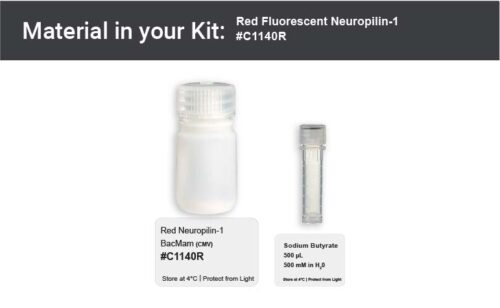 SARS-CoV-2, SARS-CoV-2 Host Proteins
SARS-CoV-2, SARS-CoV-2 Host ProteinsNeuropilin-1 BacMam – Red Fluorescent (C1140R)
$595.00Select options This product has multiple variants. The options may be chosen on the product page
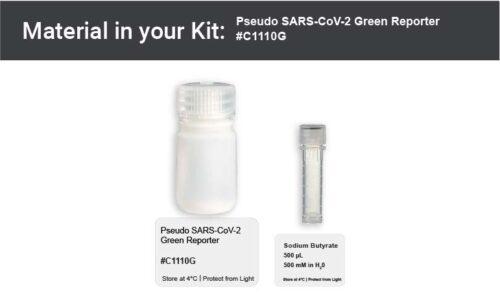 Pseudovirus, SARS-CoV-2
Pseudovirus, SARS-CoV-2Pseudo SARS-CoV-2 Green Reporter – Original Variant (C1110G)
$695.00–$3,895.00Price range: $695.00 through $3,895.00Select options This product has multiple variants. The options may be chosen on the product page
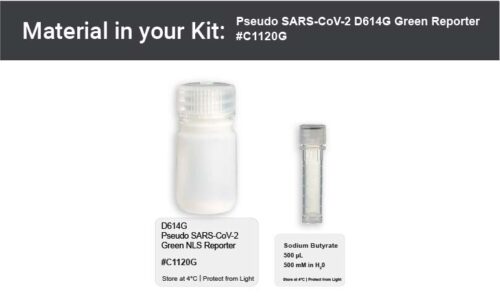 Pseudovirus, SARS-CoV-2
Pseudovirus, SARS-CoV-2Pseudo SARS-CoV-2 Virus Green Reporter – D614G (C1120G)
$695.00–$3,895.00Price range: $695.00 through $3,895.00Select options This product has multiple variants. The options may be chosen on the product page
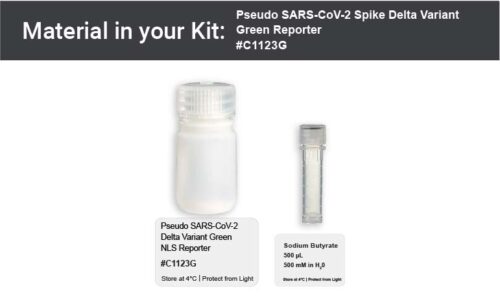 Pseudovirus, SARS-CoV-2
Pseudovirus, SARS-CoV-2Pseudo SARS-CoV-2 Virus Green Reporter – Delta Variant (C1123G)
$695.00–$3,895.00Price range: $695.00 through $3,895.00Select options This product has multiple variants. The options may be chosen on the product page
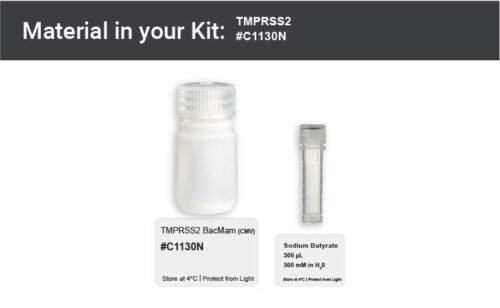 SARS-CoV-2, SARS-CoV-2 Host Proteins
SARS-CoV-2, SARS-CoV-2 Host ProteinsTMPRSS2 BacMam (C1130N)
$595.00Select options This product has multiple variants. The options may be chosen on the product page


3CLglow Assay (C1160G)
A live cell assay for SARS-CoV-2 3CLpro enzyme inhibition and activity.
Featured Publication: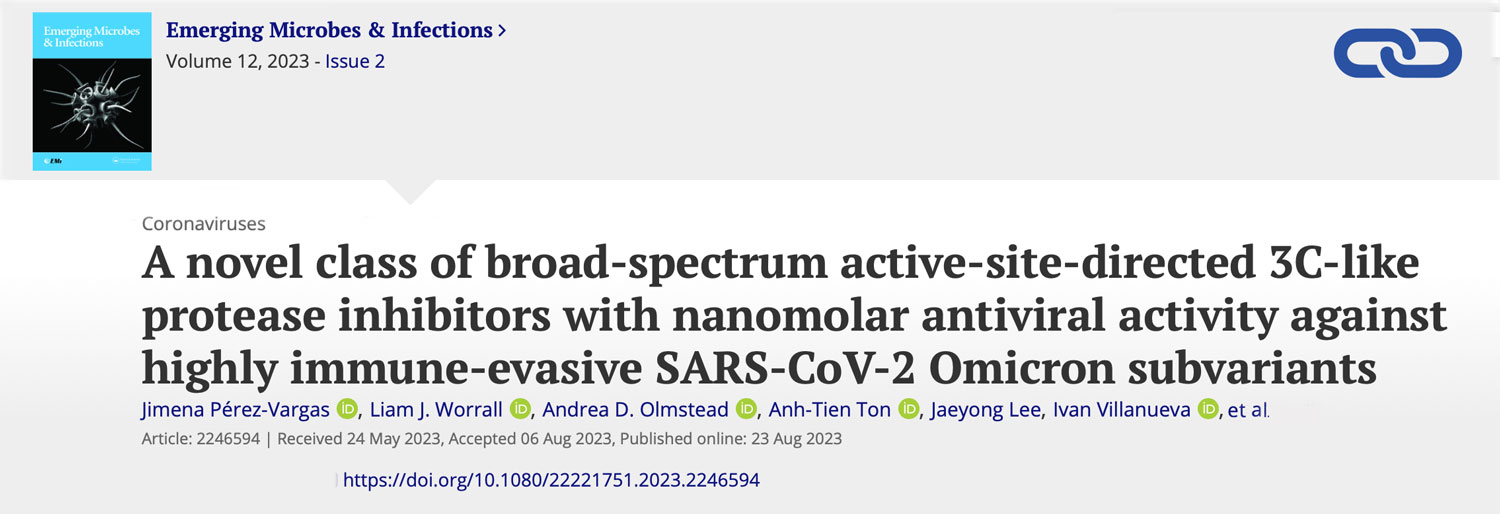 3CLpro Biosensors (3CLglow), SARS-CoV-2$695.00–$3,895.00Price range: $695.00 through $3,895.00Select options This product has multiple variants. The options may be chosen on the product page
3CLpro Biosensors (3CLglow), SARS-CoV-2$695.00–$3,895.00Price range: $695.00 through $3,895.00Select options This product has multiple variants. The options may be chosen on the product page 

3CLglowLive Assay (C1162G)
A live cell assay for SARS-CoV-2 3CLpro enzyme activity, well-suited to experiments using live SARS-CoV-2 virus.
3CLpro Biosensors (3CLglow), SARS-CoV-2$695.00–$3,895.00Price range: $695.00 through $3,895.00Select options This product has multiple variants. The options may be chosen on the product page

3CLglowUp Assay (C1161G)
A bright, fluorescent live cell assay for SARS-CoV-2 3CLpro enzyme inhibition and activity.
3CLpro Biosensors (3CLglow), SARS-CoV-2$695.00–$3,895.00Price range: $695.00 through $3,895.00Select options This product has multiple variants. The options may be chosen on the product page

3CLPro Mutant BacMam – E166A & L167F (C1206N)
Express 3CLpro with the E166A and L167F mutations in mammalian cells including HEK293, A549, and many more. Use alongside other 3CLpro mutant proteases and our 3CLglow biosensor assays to test 3CLpro inhibitor efficacy against a panel of mutations in the protease.
3CL protease and mutants, SARS-CoV-2$595.00Select options This product has multiple variants. The options may be chosen on the product page

3CLPro Mutant BacMam – E166G (C1203N)
Express 3CLpro with the E166G mutation in mammalian cells including HEK293, A549, and many more. Use alongside other 3CLpro mutant proteases and our 3CLglow biosensor assays to test 3CLpro inhibitor efficacy against a panel of mutations in the protease.
3CL protease and mutants, SARS-CoV-2$595.00Select options This product has multiple variants. The options may be chosen on the product page

3CLPro Mutant BacMam – E166V (C1202N)
Express 3CLpro with the E166V mutation in mammalian cells including HEK293, A549, and many more. Use alongside other 3CLpro mutant proteases and our 3CLglow biosensor assays to test 3CLpro inhibitor efficacy against a panel of mutations in the protease.
3CL protease and mutants, SARS-CoV-2$595.00Select options This product has multiple variants. The options may be chosen on the product page

3CLPro Mutant BacMam – H172Y (C1205N)
Express 3CLpro with the H172Y mutation in mammalian cells including HEK293, A549, and many more. Use alongside other 3CLpro mutant proteases and our 3CLglow biosensor assays to test 3CLpro inhibitor efficacy against a panel of mutations in the protease.
3CL protease and mutants, SARS-CoV-2$595.00Select options This product has multiple variants. The options may be chosen on the product page

3CLPro Mutant BacMam – L50F & E166V (C1209N)
Express 3CLpro with the L50F + E166V mutation in mammalian cells including HEK293, A549, and many more. Use alongside other 3CLpro mutant proteases and our 3CLglow biosensor assays to test 3CLpro inhibitor efficacy against a panel of mutations in the protease.
3CL protease and mutants, SARS-CoV-2$595.00Select options This product has multiple variants. The options may be chosen on the product page

3CLPro Mutant BacMam – L50F (C1201N)
Express 3CLpro with the L50F mutation in mammalian cells including HEK293, A549, and many more. Use alongside other 3CLpro mutant proteases and our 3CLglow biosensor assays to test 3CLpro inhibitor efficacy against a panel of mutations in the protease.
3CL protease and mutants, SARS-CoV-2$595.00Select options This product has multiple variants. The options may be chosen on the product page

3CLPro Mutant BacMam – L50F, E166A & L167F (C1210N)
Express 3CLpro with the L50F + E166A + L167F mutation in mammalian cells including HEK293, A549, and many more. Use alongside other 3CLpro mutant proteases and our 3CLglow biosensor assays to test 3CLpro inhibitor efficacy against a panel of mutations in the protease.
3CL protease and mutants, SARS-CoV-2$595.00Select options This product has multiple variants. The options may be chosen on the product page

3CLPro Mutant BacMam – L50F, F140L, L167F & T304I (C1214N)
Express 3CLpro with the L50F, F140L, L167F, and T304I mutations in mammalian cells including HEK293, A549, and many more. Use alongside other 3CLpro mutant proteases and our 3CLglow biosensor assays to test 3CLpro inhibitor efficacy against a panel of mutations in the protease.
3CL protease and mutants, SARS-CoV-2$595.00Select options This product has multiple variants. The options may be chosen on the product page

3CLPro Mutant BacMam – Q189E (C1204N)
Express 3CLpro with the Q189E mutation in mammalian cells including HEK293, A549, and many more. Use alongside other 3CLpro mutant proteases and our 3CLglow biosensor assays to test 3CLpro inhibitor efficacy against a panel of mutations in the protease.
3CL protease and mutants, SARS-CoV-2$595.00Select options This product has multiple variants. The options may be chosen on the product page

3CLPro Mutant BacMam – T21I & E166V (C1208N)
Express 3CLpro with the T21I + E166V mutation in mammalian cells including HEK293, A549, and many more. Use alongside other 3CLpro mutant proteases and our 3CLglow biosensor assays to test 3CLpro inhibitor efficacy against a panel of mutations in the protease.
3CL protease and mutants, SARS-CoV-2$595.00Select options This product has multiple variants. The options may be chosen on the product page

3CLPro Mutant BacMam – T21I & T304I (C1207N)
Express 3CLpro with the T21I + T304I mutation in mammalian cells including HEK293, A549, and many more. Use alongside other 3CLpro mutant proteases and our 3CLglow biosensor assays to test 3CLpro inhibitor efficacy against a panel of mutations in the protease.
3CL protease and mutants, SARS-CoV-2$595.00Select options This product has multiple variants. The options may be chosen on the product page

3CLPro Mutant BacMam – T21I (C1200N)
Express 3CLpro with the T21I mutation in mammalian cells including HEK293, A549, and many more. Use alongside other 3CLpro mutant proteases and our 3CLglow biosensor assays to test 3CLpro inhibitor efficacy against a panel of mutations in the protease.
3CL protease and mutants, SARS-CoV-2$595.00Select options This product has multiple variants. The options may be chosen on the product page

3CLPro Mutant BacMam – T21I, A173V & T304I (C1212N)
Express 3CLpro with the T21I, A173V, and T304I mutations in mammalian cells including HEK293, A549, and many more. Use alongside other 3CLpro mutant proteases and our 3CLglow biosensor assays to test 3CLpro inhibitor efficacy against a panel of mutations in the protease.
3CL protease and mutants, SARS-CoV-2$595.00Select options This product has multiple variants. The options may be chosen on the product page

3CLPro Mutant BacMam – T21I, C160F, A173V, V186A & T304I BacMam (C1215N)
Express 3CLpro with the T21I, C160F, A173V, V186A, and T304I mutations in mammalian cells including HEK293, A549, and many more. Use alongside other 3CLpro mutant proteases and our 3CLglow biosensor assays to test 3CLpro inhibitor efficacy against a panel of mutations in the protease.
3CL protease and mutants, SARS-CoV-2$595.00Select options This product has multiple variants. The options may be chosen on the product page

3CLPro Mutant BacMam – T21I, L50F, A193P & S301P (C1213N)
Express 3CLpro with the T21I, L50F, A193P, and S301P mutations in mammalian cells including HEK293, A549, and many more. Use alongside other 3CLpro mutant proteases and our 3CLglow biosensor assays to test 3CLpro inhibitor efficacy against a panel of mutations in the protease.
3CL protease and mutants, SARS-CoV-2$595.00Select options This product has multiple variants. The options may be chosen on the product page

3CLPro Mutant BacMam – T21I, S144A & T304I (C1211N)
Express 3CLpro with the T21I, S144A, and T304I mutations in mammalian cells including HEK293, A549, and many more. Use alongside other 3CLpro mutant proteases and our 3CLglow biosensor assays to test 3CLpro inhibitor efficacy against a panel of mutations in the protease.
3CL protease and mutants, SARS-CoV-2$595.00Select options This product has multiple variants. The options may be chosen on the product page

ACE2 BacMam – Green Fluorescent (C1100G)
Controlled expression of Green fluorescent ACE2 for SARS-CoV-2 drug screening.
Featured Publication: SARS-CoV-2, SARS-CoV-2 Host Proteins$595.00Select options This product has multiple variants. The options may be chosen on the product page
SARS-CoV-2, SARS-CoV-2 Host Proteins$595.00Select options This product has multiple variants. The options may be chosen on the product page 

ACE2 BacMam – Red Fluorescent (C1100R)
Controlled expression of red fluorescent ACE2 for SARS-CoV-2 drug screening.
Featured Publication: SARS-CoV-2, SARS-CoV-2 Host Proteins$595.00Select options This product has multiple variants. The options may be chosen on the product page
SARS-CoV-2, SARS-CoV-2 Host Proteins$595.00Select options This product has multiple variants. The options may be chosen on the product page 

ACE2 BacMam – Unlabeled (C1100N)
Controlled expression of ACE2 for SARS-CoV-2 drug screening.SARS-CoV-2, SARS-CoV-2 Host Proteins$595.00Select options This product has multiple variants. The options may be chosen on the product page

Cathepsin L BacMam (C1150N)
Human Cathepsin L in a BacMam vector for controlled CATL1 expression in a wide variety of cell types.SARS-CoV-2, SARS-CoV-2 Host Proteins$595.00Select options This product has multiple variants. The options may be chosen on the product page

Neuropilin 1 BacMam – Unlabeled (C1140N)
Human Neuropilin-1 (NRD1) in a BacMam vector for controlled expression in a wide variety of cell types.SARS-CoV-2, SARS-CoV-2 Host Proteins$595.00Select options This product has multiple variants. The options may be chosen on the product page

Neuropilin-1 BacMam – Red Fluorescent (C1140R)
Red fluorescent labeled Neuropilin-1 in a BacMam vector for controlled expression in a wide variety of cell types.SARS-CoV-2, SARS-CoV-2 Host Proteins$595.00Select options This product has multiple variants. The options may be chosen on the product page

Pseudo SARS-CoV-2 Green Reporter – Original Variant (C1110G)
Baculovirus pseudotyped with SARS-CoV-2 Spike protein. A covid pseudovirus that will produce green fluorescent nuclei upon successful entry, into host cells expressing ACE2.
Featured Publication:Pseudovirus, SARS-CoV-2$695.00–$3,895.00Price range: $695.00 through $3,895.00Select options This product has multiple variants. The options may be chosen on the product page

Pseudo SARS-CoV-2 Virus Green Reporter – D614G (C1120G)
Baculovirus pseudotyped with SARS-CoV-2 D614G mutated spike protein that binds with ACE2 and expresses green fluorescent protein at the nucleus 24 hours after viral entry.
Featured Publication: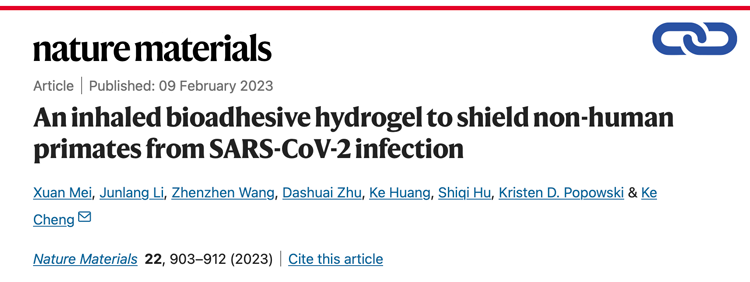 Pseudovirus, SARS-CoV-2$695.00–$3,895.00Price range: $695.00 through $3,895.00Select options This product has multiple variants. The options may be chosen on the product page
Pseudovirus, SARS-CoV-2$695.00–$3,895.00Price range: $695.00 through $3,895.00Select options This product has multiple variants. The options may be chosen on the product page 

Pseudo SARS-CoV-2 Virus Green Reporter – Delta Variant (C1123G)
Baculovirus pseudotyped with SARS-CoV-2 Delta Variant Spike protein, also known as B.1.617.2. The pseudovirus will produce green fluorescent nuclei upon successful entry, into host cells expressing ACE2.
Featured Publication: Pseudovirus, SARS-CoV-2$695.00–$3,895.00Price range: $695.00 through $3,895.00Select options This product has multiple variants. The options may be chosen on the product page
Pseudovirus, SARS-CoV-2$695.00–$3,895.00Price range: $695.00 through $3,895.00Select options This product has multiple variants. The options may be chosen on the product page 

TMPRSS2 BacMam (C1130N)
Human TMPRSS2 in BacMam for controlled expression in live mammalian cells and increased Spike binding.SARS-CoV-2, SARS-CoV-2 Host Proteins$595.00Select options This product has multiple variants. The options may be chosen on the product page
